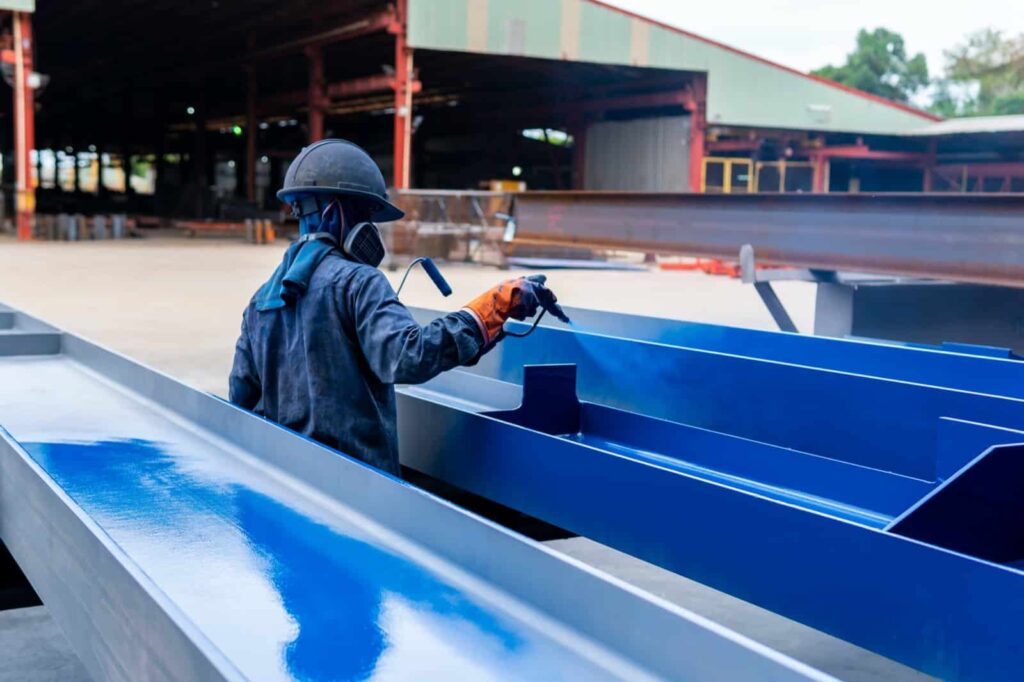
What is Electrostatic Painting, and Why is it Beneficial?
In industrial and commercial settings, durability is a must. This rings true for the paint you choose for your facility and assets, too. The paint needs to be durable enough to protect what’s underneath to ensure you get the most out of your investment. That’s where electrostatic painting steals the spotlight.
Electrostatic painting is an intriguing painting technique that enhances efficiency, reduces waste, and improves the quality of whatever it’s painted on. But what is electrostatic painting, exactly, and why might it be beneficial for your business? Let’s find out.
Understanding Electrostatic Painting
Electrostatic painting is a specific painting technique that leverages the power of an electric charge to apply paint to conductive surfaces. Painters add this electric charge to atomized paint, which gives it a positive charge.
Once charged, painters spray the paint onto a negatively charged object, often made of metal or plastic. There’s an incredibly strong pull between the positively charged paint and negatively charged object—that attraction is about 75 times stronger than gravity!
Why is Electrostatic Painting Used?
Electrostatic spray painting is a go-to pick for all sorts of reasons, namely for its durability, phenomenal transfer efficiency, and quick-drying nature:
- Efficient transfer: Thanks to the strong pull between the paint and the object, more paint sticks to the object when painting, which translates to less waste overall.
- Durable finish: The ionic bonds between the positively-charged paint and negatively-charged object, be it a metal aerospace part or molding plastic, add an extra layer of durability through a long-lasting finish.
- Quick drying: This paint, unlike other paints, takes mere minutes to dry. This makes application a breeze and keeps downtime to a minimum.
- Cost-effectiveness: Given its remarkable transfer efficiency, which substantially limits issues like paint waste, overspray, and the need for extra coats, electrostatic paint is a cost-effective option.
- Environmental benefits: Electrostatic painting is considered a more eco-friendly technique than other forms of painting because it dramatically reduces overspray and waste. This means less paint ends up in the air, which is an all-around bonus.
Types of Facilities and Assets That Use Electrostatic Painting
Electrostatic painting is a staple in a wide variety of applications. It’s more common in industrial settings, thanks to its array of benefits, such as improved durability, transfer efficiency, and cost-effective nature. It’s often used in these industries or for these applications:
- Manufacturing plants
- Metal equipment and machinery
- Transportation equipment
- Structural components
- Appliances
- Coating and molding plastics
- Automotive industry
- Medical industry
- Military industry
- Aerospace industry
How Electrostatic Painting Can Benefit Your Business
Electrostatic paint can be a great way to upgrade your facility or assets. It goes a long way in enhancing the longevity and quality of your equipment, making it a phenomenal investment. It’s an advanced painting technique that not only ensures a superior, aesthetically pleasing finish but also is incredibly durable.
The exceptional transfer efficiency, which reduces overspray and paint waste, leads to a cleaner application process and less downtime for your operations. On top of that, you get the added benefit of electrostatic painting’s environmental benefits, which is ideal for facilities aiming to adopt more sustainable practices, like lower emissions and a smaller ecological footprint.
Combined, these advantages make electrostatic painting a worthwhile investment, especially for industrial applications that require the best of functionality, appearance, and eco-friendly features.
Upgrade Your Facility With McLean Painting: Electrostatic Painting Near You
If you’re ready to upgrade your facility or assets with electrostatic painting, our industrial painting services at McLean Company are here to help. We’re committed to helping you achieve long-term performance and a professional look, regardless of whether you’re repainting expensive equipment or finishing a large metal structure during warehouse construction.
When you’re ready to take your facility or assets to the next level with a coat of electrostatic paint, contact our team at McLean Company. We provide industrial and commercial painting and flooring services to businesses and organizations in and around northeastern Massachusetts. Contact us today to start with a free quote!
Frequently Asked Questions (FAQs)
What Types of Paints Are Used in the Electrostatic Painting Process?
Electrostatic painting typically uses a specially formulated paint that is designed for this purpose. These paints are designed to be atomized and can carry an electric charge. They may be solvent-based, water-based, or powder coatings, with the specific type varying based on the application, substrate material, and the desired finish.
How Does the Cost of Electrostatic Painting Compare to Traditional Painting Methods?
Generally speaking, electrostatic painting is more cost-effective in the long run than traditional painting methods. The superior transfer efficiency limits waste and overspray, which translates to fewer coats needed and less cleanup. On top of that, the finish’s durability can mean less frequent repainting, resulting in lower overall maintenance costs for businesses.
Are There Any Limitations or Restrictions on What Can Be Painted Using Electrostatic Painting?
Electrostatic painting doesn’t work for all applications. This technique is best suited to conductive surfaces, usually metals and conductive plastics. Non-conductive materials might not hold the charge effectively, requiring different application methods.
